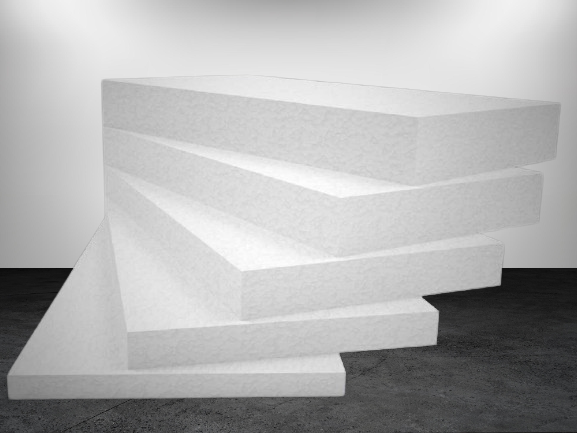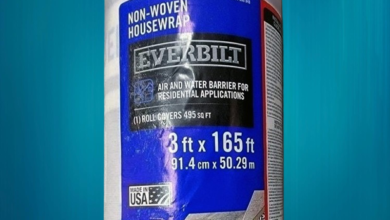Can You Revamp Your Ceiling With Foam Board?

PVC, MDF, plywood, wood panels, and gypsum board are the materials most often used in interior ceiling construction.
These materials are the preferred choices because they satisfy local building codes and improve the interior beauty of the residential or commercial property.
Could foam board be one of the many materials that can be used for an interior ceiling, given their variety? That’s what today’s article will find out, though.
Can Foam Board Be Used for Interior Ceilings?
It is possible to use foam board for interior ceilings. However, there are a few things you should consider.
The best material for ceilings is foam board. Because of its light weight, installation is simple. Insulation on an interior ceiling is greatly enhanced by the use of foam board.
But in order to make foam board more impact-resistant, you must cover it with sheathing before installing it on a ceiling. If there will be heating on the floor below, it must also be weatherproofed.
But that’s not all. Since foam board is extremely flammable, it needs to be covered with a fire-resistant material when installed on an interior ceiling. Most local building codes require the use of fire-resistant materials.
Please be aware that installing foam board on interior ceilings has advantages and disadvantages. I’ll go into more detail about these below. Therefore, take your time making a decision and learn about all the aspects of this project.
What Advantages Do Foam Boards Offer For Interior Ceilings?
One common kind of sheathing that is well-known for its insulating qualities is foam board. Mostly, walls are used with it. However, in some situations, ceilings can also be treated with it. The following are a few advantages of the latter:
- It increases energy efficiency—This is one of foam board’s best qualities in my opinion. Foam board’s ability to insulate heat makes it an excellent choice for enhancing the energy efficiency of your home or place of business.
Thus, you’ll benefit from cheap power costs. Additionally, installing foam board on your ceiling will guarantee that your house is always warm if you reside in a colder climate.
- It soundproofs the interior – It’s a great idea to use foam board on the interior ceiling if you want to block out noise from the outside or the inside.
Additionally, foam board has superior sound-absorbing qualities. Additionally, this can be useful when building the ceilings of loud interior spaces like theaters, restaurants, bars, and so forth.
- It facilitates installation –Foam board is comparatively simpler to install than other ceiling materials. It’s incredibly light and knife-cuts fairly easily.
Foam board is a great alternative if you’re building a ceiling on your own and don’t want to deal with bulky materials.
- It improves the aesthetics of your interior ceiling: foam board ceiling tiles are available in a variety of shapes and patterns. Once installed, these can add some flair to the interior design.
- Certain foam boards can withstand moisture well; these are great materials to use for high-moisture ceilings, such as those in kitchens and bathrooms.
This extends the life of your ceiling and guards against problems like mold development and moisture damage.
What Hazards Come With Applying Foam Board To Interior Ceilings?
However, foam board is not the ideal material for an interior ceiling because of a few problems. Among these restrictions are
- It’s weak – Due to its structural weakness, foam board cannot be utilized as a stand-alone ceiling material. Foam board is easily collapsed when used alone, particularly when hanging heavy objects like chandeliers.
Therefore, it needs to be supplemented with other materials in order to provide reinforcement.
- It burns easily – Flame-resistant building materials are mandated by almost all building codes. Foam board is unfortunately highly flammable, so there is some risk involved when using it for an interior ceiling.
- Not all foam boards can withstand moisture. For example, EPS foam boards can absorb and transfer moisture to other materials, such as framing, when used on a ceiling.
- Some foam boards release volatile organic compounds (VOCs) – When foam board is still relatively new, there’s a good chance it will release volatile organic compounds that can have an impact on indoor air quality.
Those who have respiratory issues may find this problematic. Fortunately, off-gassing typically lasts a short while.
Is it permissible to use foam board for interior ceilings according to local building codes?
Over the years, I’ve come to the conclusion that most building codes don’t object to foam board being used for interior ceilings.
But the foam board needs to be covered with a flame retardant layer in order to pass an inspector’s inspection. To avoid moisture issues, certain building codes may also recommend using vapor retarders.
These are the only two building code-related concerns that could come up.
However, you should be aware that building codes differ by location. You should find out how the local authorities feel about using foam board for the interior ceiling.
How Can Foam Board Be Installed On An Interior Ceiling?
Allow me to walk you through a brief installation guide now that you are aware of the benefits and drawbacks of using foam board for interior ceilings.
As was already mentioned, working with foam board is very simple. Thus, the installation procedure ought to go quite easily.
- Step 1: Compile Necessary Materials
Foam boards, glue, scissors, tape measure, tape, furring strips, and a set of fasteners are all included in this.
- Step 2: Arrange Your Workspace
Should this be an existing ceiling, the old materials must be removed. In addition, you’ll need to clean up a little and inspect the wiring.
- Step 3: Cut the foam board to the height that you want.
Determine the perfect size of foam boards you’ll need for this project by measuring with a tape measure. then cut the foam boards to the necessary sizes with a knife.
- Step 4: Construct a Ceiling Frame
Although some people omit this step, I believe it to be crucial. A frame provides the ideal surface on which to place a foam board.
It guarantees that your foam board sticks to the ceiling firmly and aids in shaping the ceiling design. So make a frame with some furring strips.
- Step 5: Apply Adhesive to the Foam Board’s Back
Adhesive is essential for making sure the foam board adheres firmly to the frame. Make sure the adhesive is all over the surface before securing it to the furring strips.
- Step 6: Attach the fasteners to the furring strips.
A solid adhesion between the foam board and the frame should be your aim. Thus, take a few fasteners and insert them all the way through the foam board to the furring strips.
Verify that the fasteners are spaced evenly apart. Before moving on to the next step, make sure the foam board is completely adhered to the surface.
- Step 7: Complete the installation and seal the seams
Seal the seams to prevent the leaking of moisture or air before beginning the finishing process. This will encourage effective insulation as well.
Foil tape can be used to seal the foam board’s seams. That’s it; your interior ceiling’s foam board installation is complete.
Remember to apply a specialized coating to the foam board to make it fireproof afterward. Alternatively, you could search for foam board with a higher fire rating.

